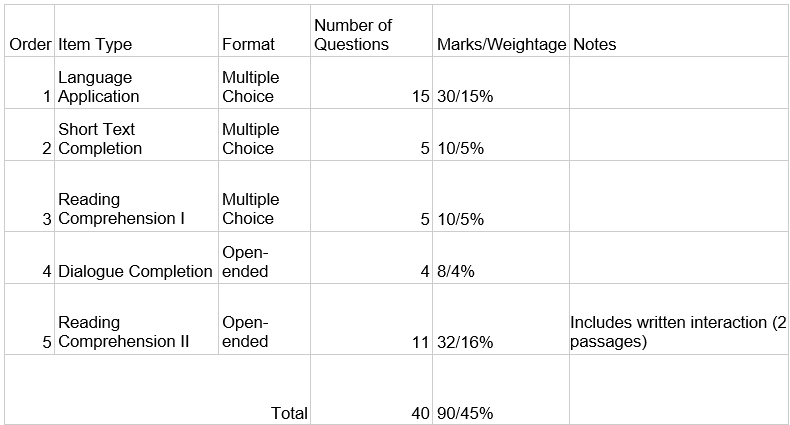The PSLE Chinese exam can feel like a looming mountain for both parents and students. But fear not! With a clear understanding of the format, helpful preparation tips, and a supportive atmosphere, your child can confidently conquer this important exam.
Exam Structure: Unpacking the Components
The PSLE Chinese exam is a two-pronged assessment, testing your child's written and oral communication skills in the language.
Written Paper: This paper is typically the first to be tackled and is designed to evaluate your child's grasp of grammar, vocabulary, and writing ability. It usually involves a combination of:
- Multiple-choice questions: These quick-fire questions assess your child's understanding of basic concepts and vocabulary.
- Structured response questions: These questions require short, focused answers that demonstrate your child's ability to apply their knowledge.
- Comprehension passage: This section tests your child's reading comprehension and ability to analyse information. They may be asked to answer questions based on a passage or complete tasks related to it.
- Composition: This is the pièce de résistance of the written paper, testing your child's ability to express themselves clearly and creatively. Topics typically range from everyday experiences to imaginative scenarios.
Oral Exam: This component evaluates your child's spoken Mandarin and listening skills. It usually involves a combination of:
- Reading aloud: Your child will be presented with a short passage to read aloud, demonstrating pronunciation and fluency.
- Conversation: The examiner will engage your child in a conversation on a familiar topic, assessing their listening comprehension and ability to respond naturally.
- Picture description: Your child will be presented with a picture and asked to describe it in detail, demonstrating their vocabulary and ability to organise their thoughts.
Demystifying the Weightage:
While the exact weightage might vary slightly across years, the written paper generally carries a larger portion of the overall score (around 75%). This emphasises the importance of strong reading, writing, and critical thinking skills. However, don't underestimate the oral component (around 25%)! Effective communication skills are crucial in any language, and the oral exam reflects that.
Booklet 1: Writing (40 marks)

Booklet 2: Language Application and Reading Comprehension (90 marks)

Booklet 3: Oral (50 marks)

Booklet 4: Listening (20 marks)

Beyond the Exam: Preparing for Success
Here are some practical tips to help your child approach the PSLE Chinese exam with confidence:
- Immersion is Key: Encourage your child to surround themselves with the Chinese language as much as possible. Watch Chinese cartoons, listen to Mandarin music, and read children's books in Chinese.
- Practice Makes Perfect: Utilise past PSLE Chinese papers and practice tests to familiarise your child with the exam format and question styles. This can help build confidence and improve time management skills.
- Embrace Learning Resources: Textbooks, workbooks, and online learning platforms can be valuable tools for reinforcing classroom learning. Encourage your child to explore these resources for additional practice.
- Seek Supportive Guidance: If your child needs extra help, consider enrolling them in tuition classes or seeking guidance from their school teacher.
- Positive Reinforcement: Create a supportive learning environment at home. Show an interest in your child's progress, celebrate their achievements, and offer encouragement when they face challenges.
Is there higher Chinese in PSLE?
Yes, Higher Chinese (HCL) is available in the PSLE:
- PSLE Higher Chinese grading system
The Higher Chinese Language (HCL) paper is worth 100 marks and consists of two components: composition writing and a written comprehension paper. The grading system is as follows: Unclassified (<50), Pass (50-64), Merit (65-79), and Distinction (≥80).
- Benefits of taking HCL
- Strong Language Foundation: Develops a solid foundation in Chinese language acquisition.
- Enhanced Comprehension: Improves understanding of Chinese grammar and vocabulary.
- SAP School Advantage: Students who pass HCL with a PSLE score of 14 or higher may have an advantage when applying to Special Assistance Plan (SAP) schools, which emphasise bilingualism.
- Eligibility for HCL
To be eligible for HCL, students must be among the top 11% to 30% of students with an "A*" grade in Chinese. - Benefits of scoring well in HCL
Students who pass HCL and have a PSLE score of 14 or better may receive an advantage when applying to SAP schools. - Opting out of HCL
Students have the option to opt out of HCL in Primary 5 if they wish.
Where to Find PSLE Chinese Books
There are many PSLE Chinese books available on the market. You can find them at bookstores, libraries, and online retailers.
The Openschoolbag PSLE Series is a popular choice among Singaporean parents and students. It offers comprehensive coverage of the PSLE Chinese syllabus, including:
- Past papers: Practice with authentic PSLE Chinese papers from previous years.
- Answer keys and model answers: Gain insights into the expected standard of answers.
- Detailed explanations: Understand the reasoning behind the correct answers.
- Practice questions: Additional exercises to reinforce learning.
By understanding the PSLE Chinese exam structure, implementing practical preparation techniques, and fostering a positive learning environment, you can empower your child to approach this important stage with confidence and a strong foundation in the Chinese language.
